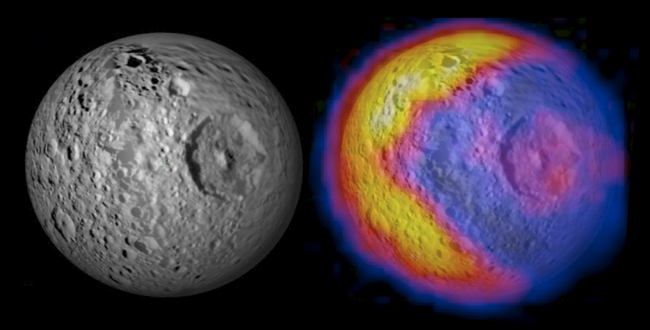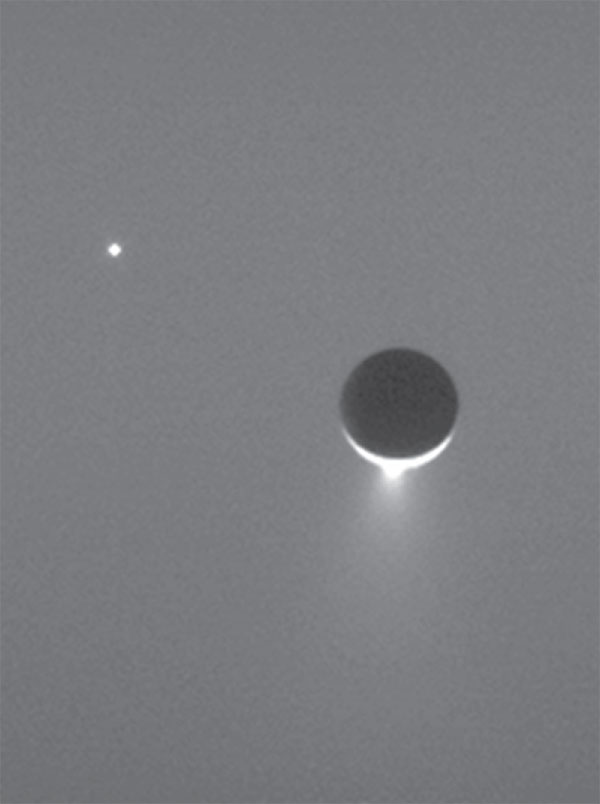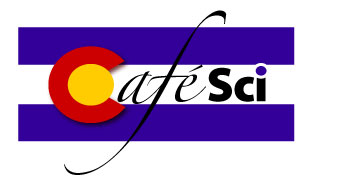About the topic
Bio
Get the Flyer (pdf)
About the topic
NASA's Cassini spacecraft has been exploring Saturn's system of moons for over six years now, revealing an amazing variety of landscapes both Earth-like and utterly alien. The largest moon, Titan, hides an Earth-like surface of lakes and rivers beneath its dense, smoggy, atmosphere, but the rivers are filled with methane, not water. Meanwhile one of the smaller moons, Enceladus, continually blasts jets of ice particles, perhaps escaping from misty saltwater caverns, into orbit around Saturn. Other moons in Saturn's menagerie resemble a walnut, a sponge, and the Death Star. All these varied worlds have stories to tell us about how the solar system came to be, and how we humans came to be a part of it.
For example, the Death Star moon, Mimas, (see the picture below) which does look a lot like the Star Wars item: Speaker John Spencer and other scientists working with the composite infrared spectrometer, which mapped Mimas' temperatures, expected smoothly varying temperatures peaking in the early afternoon near the equator. Instead, the warmest region was in the morning, along one edge of the moon's disk, making a sharply defined Pac-Man shape, with temperatures around 92 Kelvin (minus 294 degrees Fahrenheit). The rest of the moon was much colder, around 77 Kelvin (minus 320 degrees Fahrenheit). A smaller warm spot -- the dot in Pac-Man's mouth -- showed up around the Herschel crater, with a temperature around 84 Kelvin (minus 310 degrees Fahrenheit).

 In the picture here, Saturn's icy moon Enceladus — backlit by the Sun and accompanied by a background star (top left) in this image taken by the Cassini spacecraft on 24 March 2006 — spews ice grains into space from jets at its south pole. The bright background sky, which makes the night side of Enceladus seem dark by contrast, is a small portion of Saturn's E ring, which is composed of ice grains accumulated from decades of output from the Enceladus jets. Analysis of these grains, and the gas that accompanies them, is providing new clues about a possible subsurface ocean that might supply the jets.
In the picture here, Saturn's icy moon Enceladus — backlit by the Sun and accompanied by a background star (top left) in this image taken by the Cassini spacecraft on 24 March 2006 — spews ice grains into space from jets at its south pole. The bright background sky, which makes the night side of Enceladus seem dark by contrast, is a small portion of Saturn's E ring, which is composed of ice grains accumulated from decades of output from the Enceladus jets. Analysis of these grains, and the gas that accompanies them, is providing new clues about a possible subsurface ocean that might supply the jets.
Bio
 John Spencer, PhD, is an Institute Scientist at Southwest Research
Institute's Department of Space Studies in Boulder, Colorado. A
native of England, he obtained a Bachelor's degree in Geology from the
University of Cambridge in 1978, and his PhD in Planetary Sciences
from the University of Arizona in 1987. He spent four years in
postdoctoral positions at the University of Hawaii before joining the
staff of Lowell Observatory in Flagstaff, Arizona, in 1991. He worked
there till he joined Southwest Research Institute in January 2004.
John Spencer, PhD, is an Institute Scientist at Southwest Research
Institute's Department of Space Studies in Boulder, Colorado. A
native of England, he obtained a Bachelor's degree in Geology from the
University of Cambridge in 1978, and his PhD in Planetary Sciences
from the University of Arizona in 1987. He spent four years in
postdoctoral positions at the University of Hawaii before joining the
staff of Lowell Observatory in Flagstaff, Arizona, in 1991. He worked
there till he joined Southwest Research Institute in January 2004.
He specializes in studies of the moons of the outer planets, particularly the four large "Galilean" satellites of Jupiter, using theoretical models, Earth-based telescopes, close-up spacecraft observations, and the Hubble Space Telescope. He was responsible for temperature mapping of Jupiter's moons with the Photopolarimeter-Radiometer (PPR) instrument on the Jupiter-orbiting Galileo spacecraft, and is working on the mapping of temperatures on Saturn's moons using the Composite Infrared Spectrometer (CIRS) on the Cassini Saturn orbiter. He is particularly interested in the active volcanos and atmosphere of Jupiter's moon Io, and in the active ice eruptions of Saturn's moon Enceladus. He has also published research on Mars, asteroids, Pluto, and Neptune's moon Triton, and is a science team member on the New Horizons mission to Pluto and the Kuiper belt.
He was co-leader of the science team for NASA's 2007 study of a possible Flagship mission to Enceladus, is a member of the science team for the ongoing study of the Jupiter Europa Orbiter mission, and is leading the Satellites panel of the 2009 Planetary Decadal Survey.
His observational work has included discovery of several major volcanic eruptions on Io, the first observations of Io's volcanic plumes with the Hubble Space Telescope; discovery of sulfur gas in Io's plumes; co-discovery that Io's atmosphere is highly asymmetrical; co-discovery of ice volcanic activity on Saturn's moon Enceladus; and co-discovery of oxygen on Jupiter's moon Ganymede. His theoretical work has provided a probable explanation for the extreme albedo dichotomy of Iapetus, and has improved our understanding of nitrogen frost on Pluto and Triton, water frost on Jupiter's moons, and heat radiation from asteroids.
